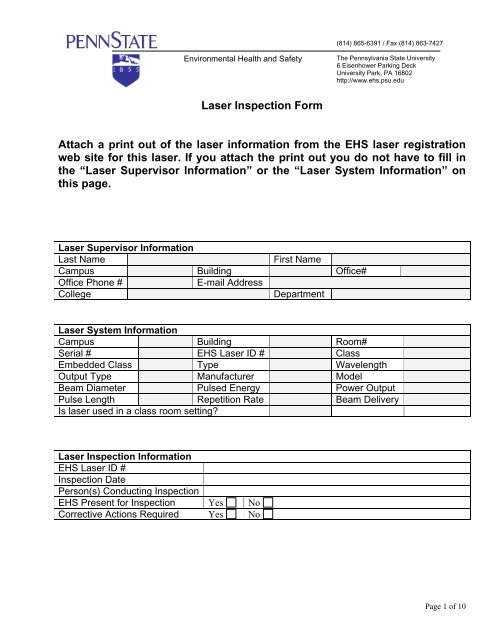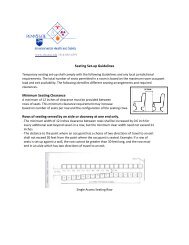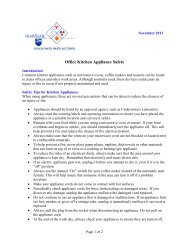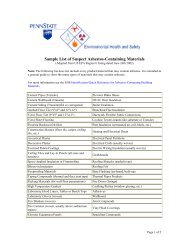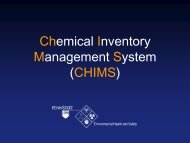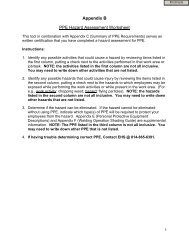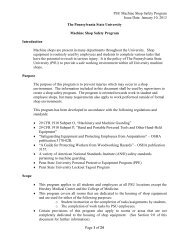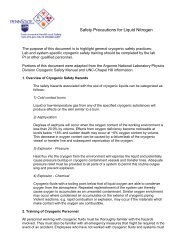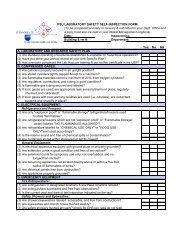Laser Safety Self Inspection Form - Penn State University ...
Laser Safety Self Inspection Form - Penn State University ...
Laser Safety Self Inspection Form - Penn State University ...
Create successful ePaper yourself
Turn your PDF publications into a flip-book with our unique Google optimized e-Paper software.
(814) 865-6391 / Fax (814) 863-7427Environmental Health and <strong>Safety</strong>The <strong>Penn</strong>sylvania <strong>State</strong> <strong>University</strong>6 Eisenhower Parking Deck<strong>University</strong> Park, PA 16802http://www.ehs.psu.edu<strong>Laser</strong> <strong>Inspection</strong> <strong>Form</strong>Attach a print out of the laser information from the EHS laser registrationweb site for this laser. If you attach the print out you do not have to fill inthe “<strong>Laser</strong> Supervisor Information” or the “<strong>Laser</strong> System Information” onthis page.<strong>Laser</strong> Supervisor InformationLast NameFirst NameCampus Building Office#Office Phone #E-mail AddressCollegeDepartment<strong>Laser</strong> System InformationCampus Building Room#Serial # EHS <strong>Laser</strong> ID # ClassEmbedded Class Type WavelengthOutput Type Manufacturer ModelBeam Diameter Pulsed Energy Power OutputPulse Length Repetition Rate Beam DeliveryIs laser used in a class room setting?<strong>Laser</strong> <strong>Inspection</strong> InformationEHS <strong>Laser</strong> ID #<strong>Inspection</strong> DatePerson(s) Conducting <strong>Inspection</strong>EHS Present for <strong>Inspection</strong> Yes NoCorrective Actions Required Yes NoPage 1 of 10
(814) 865-6391 / Fax (814) 863-7427Environmental Health and <strong>Safety</strong>The <strong>Penn</strong>sylvania <strong>State</strong> <strong>University</strong>6 Eisenhower Parking Deck<strong>University</strong> Park, PA 16802http://www.ehs.psu.eduDuring the inspection the following items were checked and were found to be Satisfactory,Not Satisfactory, or Not Applicable. Check Applicable Box.Entrance properly posted Satisfactory Not Satisfactory N/ADescription of Deficiency:Corrective Action(s) Implemented:Corrective Actions Completed on: Date:Guidance: All signs shall be conspicuously displayed in locations where they best willserve to warn onlookers. Templates for printing your own signs are available on thelaser safety page of the EHS web site.Room security adequate Satisfactory Not Satisfactory N/ADescription of Deficiency:Corrective Action(s) Implemented:Corrective Actions Completed on: Date:Guidance: Are engineering or administrative controls in place to prevent someone fromentering the area while the laser is running and being exposed to the beam.Door interlock system Satisfactory Not Satisfactory N/ADescription of Deficiency:Corrective Action(s) Implemented:Corrective Actions Completed on: Date:Guidance: If a door to the laser area is opened while the laser is running will thatautomatically shut down the laser beam.Interlock Functioning Satisfactory Not Satisfactory N/ADescription of Deficiency:Corrective Action(s) Implemented:Corrective Actions Completed on: Date:Guidance: Test the door interlock by opening the door to verify that the laser is shutdown and no exposure hazard exsist.<strong>Laser</strong> Status indicator outside Satisfactory Not Satisfactory N/AroomDescription of Deficiency:Corrective Action(s) Implemented:Corrective Actions Completed: Date:Guidance: Is there an audible and/or illuminated sign outside of the laser area thatindicates that the laser is being activated or in use.Page 2 of 10
(814) 865-6391 / Fax (814) 863-7427Environmental Health and <strong>Safety</strong>The <strong>Penn</strong>sylvania <strong>State</strong> <strong>University</strong>6 Eisenhower Parking Deck<strong>University</strong> Park, PA 16802http://www.ehs.psu.edu<strong>Laser</strong> class label in place Satisfactory Not Satisfactory N/ADescription of Deficiency:Corrective Action(s) Implemented:Corrective Actions Completed on: Date:Guidance: Commercial laser products manufactured in compliance with Federal <strong>Laser</strong>Product Performance Standard (FLPPS) will be certified by the manufacturer and willincorporate this control.<strong>Laser</strong> Hazard label in place Satisfactory Not Satisfactory N/ADescription of Deficiency:Corrective Action(s) Implemented:Corrective Actions Completed on: Date:Guidance: Commercial laser products manufactured in compliance with Federal <strong>Laser</strong>Product Performance Standard (FLPPS) will be certified by the manufacturer and willincorporate this control.<strong>Laser</strong> aperture label in place Satisfactory Not Satisfactory N/ADescription of Deficiency:Corrective Action(s) Implemented:Corrective Actions Completed on: Date:Guidance: Commercial laser products manufactured in compliance with Federal <strong>Laser</strong>Product Performance Standard (FLPPS) will be certified by the manufacturer and willincorporate this control.Protective housing in place Satisfactory Not Satisfactory N/ADescription of Deficiency:Corrective Action(s) Implemented:Corrective Actions Completed on: Date:Guidance: Commercial laser products manufactured in compliance with Federal <strong>Laser</strong>Product Performance Standard (FLPPS) will be certified by the manufacturer and willincorporate this control.Interlock on housing Satisfactory Not Satisfactory N/ADescription of Deficiency:Corrective Action(s) Implemented:Corrective Actions Completed on: Date:Guidance: Commercial laser products manufactured in compliance with Federal <strong>Laser</strong>Product Performance Standard (FLPPS) will be certified by the manufacturer and willincorporate this control.Page 3 of 10
(814) 865-6391 / Fax (814) 863-7427Environmental Health and <strong>Safety</strong>The <strong>Penn</strong>sylvania <strong>State</strong> <strong>University</strong>6 Eisenhower Parking Deck<strong>University</strong> Park, PA 16802http://www.ehs.psu.eduInterlock on housing functioning Satisfactory Not Satisfactory N/ADescription of Deficiency:Corrective Action(s) Implemented:Corrective Actions Completed on: Date:Guidance: If the laser has had no modifications and is as received from themanufacturer the interlock functionality check can be skiped. If the housing has beenremoved for any reason the interlock must be checked. To check the interlock removethe housing and try to actuate the laser. If the laser does not start the interlock isfunctioning. Please take safety percautions in the event the interlock is faulty and thelaser activates during this test.Beam Shutter present Satisfactory Not Satisfactory N/ADescription of Deficiency:Corrective Action(s) Implemented:Corrective Actions Completed on: Date:Guidance: Does the protective housing have a beam shutter or attenuator that iscapable of preventing access to laser radiation when the laser or laser system output isnot required, as in warn up procedures.Key operation Satisfactory Not Satisfactory N/ADescription of Deficiency:Corrective Action(s) Implemented:Corrective Actions Completed on: Date:Guidance: Commercial laser products manufactured in compliance with Federal <strong>Laser</strong>Product Performance Standard (FLPPS) will be certified by the manufacturer and willincorporate this control.<strong>Laser</strong> activation indicator on Satisfactory Not Satisfactory N/AconsoleDescription of Deficiency:Corrective Action(s) Implemented:Corrective Actions Completed on: Date:Guidance: Does the control console have an indicator that shows the operating status ofthe laser. That it is on, energized, or off.Page 4 of 10
(814) 865-6391 / Fax (814) 863-7427Environmental Health and <strong>Safety</strong>The <strong>Penn</strong>sylvania <strong>State</strong> <strong>University</strong>6 Eisenhower Parking Deck<strong>University</strong> Park, PA 16802http://www.ehs.psu.eduEmergency Shutoff available Satisfactory Not Satisfactory N/ADescription of Deficiency:Corrective Action(s) Implemented:Corrective Actions Completed on: Date:Guidance: Test the Emergency Shutoff to verify that it is functionally properly.<strong>Laser</strong> secured to table Satisfactory Not Satisfactory N/ADescription of Deficiency:Corrective Action(s) Implemented:Corrective Actions Completed on: Date:Guidance: Is the laser in such a state that it can not be inadvertantly bumped causing astray beam.<strong>Laser</strong> optics secured to prevent Satisfactory Not Satisfactory N/Astray beamsDescription of Deficiency:Corrective Action(s) Implemented:Corrective Actions Completed on: Date:Guidance: Are the optics secured to prevent inadvertant bumping causing a stray beam.<strong>Laser</strong> not at eye level Satisfactory Not Satisfactory N/ADescription of Deficiency:Corrective Action(s) Implemented:Corrective Actions Completed on: Date:Guidance: Make sure the laser beam is not at a level that would be eye level for aperson casually walking through room.Windows in room covered Satisfactory Not Satisfactory N/ADescription of Deficiency:Corrective Action(s) Implemented:Corrective Actions Completed on: Date:Guidance: Are there any lasers in the room emitting wavelengths that are not absorbedby glass? If so, are the windows covered to protect those on the other side?Physical evidence of stray beams Satisfactory Not Satisfactory N/ADescription of Deficiency:Corrective Action(s) Implemented:Corrective Actions Completed on: Date:Guidance: Check the area for burn marks and signs of smoke residuePage 5 of 10
(814) 865-6391 / Fax (814) 863-7427Environmental Health and <strong>Safety</strong>The <strong>Penn</strong>sylvania <strong>State</strong> <strong>University</strong>6 Eisenhower Parking Deck<strong>University</strong> Park, PA 16802http://www.ehs.psu.eduSOP Available Satisfactory Not Satisfactory N/ADescription of Deficiency:Corrective Action(s) Implemented:Corrective Actions Completed on: Date:Guidance: The <strong>Laser</strong> <strong>Safety</strong> SOP must be available in the general area of the laserAll users have completed EHS Satisfactory Not Satisfactory N/Alaser safety trainingDescription of Deficiency:Corrective Action(s) Implemented:Corrective Actions Completed on: Date:Guidance: This Documentation must be in the laser safety SOP in the general area ofthe laserDocumentation that all users have Satisfactory Not Satisfactory N/Ahad been trained in the SOPDescription of Deficiency:Corrective Action(s) Implemented:Corrective Actions Completed on: Date:Guidance: This Documentation must be in the laser safety SOP in the general area ofthe laserProper laser eye protection is Satisfactory Not Satisfactory N/AavailableDescription of Deficiency:Corrective Action(s) Implemented:Corrective Actions Completed on: Date:Guidance: Verify that the proper eye protective is available for the laser outputsProper skin protection is available Satisfactory Not Satisfactory N/ADescription of Deficiency:Corrective Action(s) Implemented:Corrective Actions Completed on: Date:Guidance: Skin ProtectionUV laser systems or UV excitation sources can present severe hazards to exposed skinsurfaces. If the UV source cannot be enclosed to prevent scattered radiation exposure,it may be necessary to wear appropriate coverings to protect the skin. These coveringsmay include gloves, UV face shield, lab coat, etc.Page 6 of 10
(814) 865-6391 / Fax (814) 863-7427Environmental Health and <strong>Safety</strong>The <strong>Penn</strong>sylvania <strong>State</strong> <strong>University</strong>6 Eisenhower Parking Deck<strong>University</strong> Park, PA 16802http://www.ehs.psu.eduToxic laser media in use Satisfactory Not Satisfactory N/ADescription of Deficiency:Corrective Action(s) Implemented:Corrective Actions Completed on: Date:Guidance: Toxic Dye HazardsThe fluorescent dyes (used with dye lasers) can present substantial hazards due to theirtoxicity. Some of these dyes are suspected of being carcinogenic or mutagenic. Thesolvents used for mixing the dyes may be flammable, toxic, or present other healthhazards. Material <strong>Safety</strong> Data Sheets (MSDS) on dyes or solvents are available fromyour department or by contacting EHS.Because the dyes normally come in a dry power form, they are readily dispersible andshould be handled and mixed with great care. A lab coat, disposable gloves, safetyglasses or goggles, and a properly functioning chemical fume hood must be used whenhandling or mixing the dyes. Good housekeeping should be maintained before, during,and after the mixing. Use double containment adequate to contain the entire volume ofthe dye solution when they are being mixed, stored, and used. Clean up any spillsimmediately using the appropriate protective equipment. Contact EHS if you needadditional information.Cryogens in use Satisfactory Not Satisfactory N/ADescription of Deficiency:Corrective Action(s) Implemented:Corrective Actions Completed on: Date:Guidance: Cryogen HazardsSome lasers and laser systems may require the use of cryogenic liquids (liquid nitrogen,oxygen, hydrogen, etc.). These liquids present skin and eye hazards from theirextremely low temperatures and should not be handled without insulated gloves,goggles and a face shield. The dewars used for transport and storage of cryogens maypresent implosion hazards if they are made of glass. Glass dewars should be carefullywrapped with strong tape to contain glass fragments should they implode.If the cryogenic liquid is allowed to warm to room temperature, the resulting gas willexpand to more than 600 times the volume in the liquid state. Once it expands tobecome a gas, the gas may present an additional hazard (toxic, asphixiant, etc.). Thespecific hazards of the cryogen can be found in the MSDS.Page 7 of 10
(814) 865-6391 / Fax (814) 863-7427Environmental Health and <strong>Safety</strong>The <strong>Penn</strong>sylvania <strong>State</strong> <strong>University</strong>6 Eisenhower Parking Deck<strong>University</strong> Park, PA 16802http://www.ehs.psu.eduCompressed gas in use Satisfactory Not Satisfactory N/ADescription of Deficiency:Corrective Action(s) Implemented:Corrective Actions Completed on: Date:Guidance: Compressed Gas HazardsThe use of compressed gases is common in the laser laboratory. Some lasers use bothpure gases and gas mixtures as the lasing media. The high pressure of the gastranslates into substantial potential energy stored in the cylinder. If this pressure isreleased in an uncontrolled manner (such as broken nozzle) the cylinder can becomean unguided missile. Compressed gas cylinders must be properly restrained to preventdamage to the nozzle or regulator.The gases themselves may present a variety of hazards if they leak from the cylinder.Depending on the gas, it may be toxic, corrosive, flammable, etc. Again, refer to theMSDS for detailed information on the gas in question. If the hazards are sufficient, itmay be necessary to provide a gas cabinet under negative pressure to control thehazard in the case of a leak. Inform your department safety contact if compressedgases are to be used in the laser facility.Gas cylinders secured Satisfactory Not Satisfactory N/ADescription of Deficiency:Corrective Action(s) Implemented:Corrective Actions Completed on: Date:Guidance: Verify that all gas cylinders are secured so that they can not fall overHigh voltage power hazard Satisfactory Not Satisfactory N/ADescription of Deficiency:Corrective Action(s) Implemented:Corrective Actions Completed on: Date:Guidance: High Voltage Power HazardsThe high voltage power supplies associated with laser systems have been responsiblefor serious injuries and electrocutions. For this reason, it is important to know thehazards associated with your laser and the laser's power supply. Capacitor systems areof particular concern because they can remain hazardous long after the main power isdisconnected. Capacitor systems should be safely discharged several times with themain power off to reduce the hazard before beginning work.Only qualified persons should perform high voltage laser or power supply maintenanceor repair. As a precaution, a second person (knowledgeable in high voltage safety andCPR) should always be in attendance when high voltage work is being performed.Page 8 of 10
(814) 865-6391 / Fax (814) 863-7427Environmental Health and <strong>Safety</strong>The <strong>Penn</strong>sylvania <strong>State</strong> <strong>University</strong>6 Eisenhower Parking Deck<strong>University</strong> Park, PA 16802http://www.ehs.psu.eduElectrical panels are unobstructed Satisfactory Not Satisfactory N/ADescription of Deficiency:Corrective Action(s) Implemented:Corrective Actions Completed on: Date:Guidance: Verify Unobstructed access to the electrical panelX-ray radiation hazard Satisfactory Not Satisfactory N/ADescription of Deficiency:Corrective Action(s) Implemented:Corrective Actions Completed on: Date:Guidance: Collateral Radiation Hazards<strong>Laser</strong> excitation systems and power supplies may produce hazardous collateralradiation of various types. These hazards are normally controlled by the equipmenthousings, and are usually a problem only if the protective housings are removed.The laser excitation device may produce very intense UV/Visible/IR radiation that canbe hazardous. Collateral ultraviolet radiation may injure both the eye and the skin if theexposure duration is long enough. Blue light presents a special hazard because of it'sease of absorption in the retina. This "Blue Light Hazard" is thought to createphotochemical injury in the retina. Exposure to any very intense visible light source canseriously degrade color vision and night vision capabilities. Exposure to these intenselight sources should be carefully controlled or eliminated by leaving the housings inplace.<strong>Laser</strong> power supplies capable of creating energies greater than 15 kVp may be asource of x-rays if they contain high voltage vacuum tubes. Electric discharge excitationsources in lasers may also be a source of x-rays. Generally, these x-rays are lowenergy and are shielded by the equipment housings.Explosion Hazard Satisfactory Not Satisfactory N/ADescription of Deficiency:Corrective Action(s) Implemented:Corrective Actions Completed on: Date:Guidance: Explosion HazardsExplosion hazards in the laser lab include: the storage and use of flammable solventsand gases (both compressed and cryogenic) and the implosion potential from dewarsand excitation flashlamps. Proper storage and control of these sources should reducethe potential hazard.Page 9 of 10
(814) 865-6391 / Fax (814) 863-7427Environmental Health and <strong>Safety</strong>The <strong>Penn</strong>sylvania <strong>State</strong> <strong>University</strong>6 Eisenhower Parking Deck<strong>University</strong> Park, PA 16802http://www.ehs.psu.eduFire Hazard Satisfactory Not Satisfactory N/ADescription of Deficiency:Corrective Action(s) Implemented:Corrective Actions Completed on: Date:Guidance: Fire HazardsClass 4 lasers can present fire hazards. <strong>Laser</strong>s being operated in a CW mode with abeam power that exceeds 0.5 Watt can ignite or cause off-gassing in combustiblematerials left in the beam path. Beam stops, barriers, and curtains used with Class 4lasers must be made of non-combustible materials. All Class 4 laser labs should havean ABC Type extinguisher readily available as a fire precaution.LGAC production Satisfactory Not Satisfactory N/ADescription of Deficiency:Corrective Action(s) Implemented:Corrective Actions Completed on: Date:Guidance: Hazards from <strong>Laser</strong> Generated Air Contaminants (LGAC)The interaction of the laser beam with target materials may produce toxic dusts, vaporsor gases called LGAC. This is particularly true during material processing (welding,cutting, vapor deposition, etc.). Toxic products resulting from laser processing must beproperly controlled through the use of adequate ventilation and filtration. The RSOshould be consulted whenever LGAC may result from the laser use.COMMENTS:Page 10 of 10


